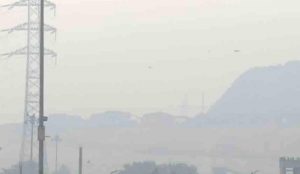Air quality in Delhi continues to remain unhealthy following the Vijayadashami celebrations. The Air Quality Index at ITO was recorded at 307 in ITO, in ‘very poor’ category as per Central Pollution Control Board (CPCB) data.
On Monday (October 26), Areas around India Gate, Akshardham and ITO were full of smog and caused breathing problems to regular morning walkers and cyclists in the city.
On Sunday evening, teh AQI at Anand Parbat was reported 403 and Ashok Vihar 1 520, both in hazardous catagories. According to reports, the air quality is deteriorating because of continuous stubble burning in the NCR region and sorrounding states.

All pollution monitoring stations in Delhi showed ‘severe’ or ‘unhealthy’ air quality index on Sunday, except two places — Delhi cantt and Naraina — according to the Central Pollution Control Board’s data.
In Ghaziabad and Gautam Buddh Nagar, the air quality reached ‘severe’ levels on Sunday evening. In Gurgaon and Faridabad, it largely remained in the ‘very poor’ category, according to a government agency.
Concentration of major air pollutants PM 2.5 and PM 10 during the morning hours largely remained in the ‘severe’ category in the four immediate neighbouring districts of Delhi, according to the air quality index (AQI) maintained by the Central Pollution Control Board (CPCB).
According to the index, an AQI between zero and 50 is considered ‘good’, 51 and 100 ‘satisfactory’, 101 and 200 ‘moderate’, 201 and 300 ‘poor’, 301 and 400 ‘very poor’, and 401 and 500 ‘severe’.
In Ghaziabad, an AQI of 416 was recorded at the station in Loni followed by 374 at Indirapuram, 354 at Sanjay Nagar and 330 at Vasundhara, according to the CPCB data at 8 pm.
In Gautam Buddh Nagar’s Noida, the AQI was 382 at Sector 116 followed by 363 at Sector 62, 356 at Sector 1.
In Greater Noida, an AQI of 423 was recorded in Knowledge Park V and 350 at Knowledge Park III, according to the CPCB figures.
In Gurgaon, an AQI of 379 was recorded at the station in Sector 51 followed by 329 at Vikas Sadan and 276 at NISE Gwal Pahari.
In Faridabad, the AQI was recorded at 366 at Sector 16A, 365 at Sector 30, 363 at New Industrial Town and 319 at Sector 11 at 8 pm.
As a possible health impact, the CPCB states an AQI in the ‘very poor’ category can lead to respiratory illness on prolonged exposure, while ?severe? affects healthy people and seriously impacts those with existing diseases.
The worsening of the air quality comes even as the Graded Response Action Plan (GRAP) has been implemented in the Delhi-National Capital Region (NCR) from October 15 to check air pollution, which spikes around this time of the year.